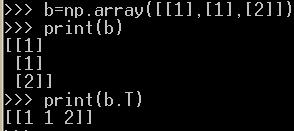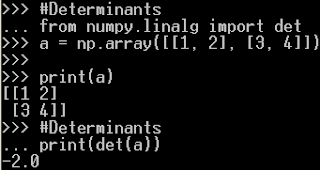1. Introduction
- I will show you how to use Python Python numpy for Linear Algebra and Matrices. We will focus on some topics:
+ Scalars, vectors and matrices
+ Vector and matrix calculations
+ Identity, inverse matrices & determinants
2. Setup
- In order to install numpy:
+ Try this first: pip install numpy if it is not successfull then follow steps below.
+ Download and unzip the package at: https://sourceforge.net/projects/numpy/files/NumPy/
+ Find where is the file setup.py and and from the command line run the command:
3.1 Scalar
- An element of a field, usually described by a real number
3.2 Vector
- Column of numbers
$\begin{bmatrix} x_{1}\\ x_{2}\\ x_{3} \end{bmatrix}$
3.3 Matrices
- Rectangular of vectors in rows and columns. Defined as rows x columns (R x C = 3x3).
$A=\begin{bmatrix} 1 & 2 & 3\\ 5 & 4 & 1\\ 6 & 7 & 4 \end{bmatrix}$
3.4 Transposition
This will change row to col and col to row.
The vector product is calculated as below
- Matrix division: A/B= A*B-1
- In numpy we have to use this: from numpy.linalg import inv
- I will show you how to use Python Python numpy for Linear Algebra and Matrices. We will focus on some topics:
+ Scalars, vectors and matrices
+ Vector and matrix calculations
+ Identity, inverse matrices & determinants
2. Setup
- In order to install numpy:
+ Try this first: pip install numpy if it is not successfull then follow steps below.
+ Download and unzip the package at: https://sourceforge.net/projects/numpy/files/NumPy/
+ Find where is the file setup.py and and from the command line run the command:
python setup.py install
- In order to use numpy in python source code, just use import:
import numpy as np
3. Let 's start3.1 Scalar
- An element of a field, usually described by a real number
3.2 Vector
- Column of numbers
$\begin{bmatrix} x_{1}\\ x_{2}\\ x_{3} \end{bmatrix}$
3.3 Matrices
- Rectangular of vectors in rows and columns. Defined as rows x columns (R x C = 3x3).
$A=\begin{bmatrix} 1 & 2 & 3\\ 5 & 4 & 1\\ 6 & 7 & 4 \end{bmatrix}$
- In order to express the matrix above, we will use array in numpy.
1 2 3 4 5 6 7 8 9 10 11 12 13 14 15 16 17 18 | import numpy as np matrix = np.array([[1, 2, 3], [5, 4, 1], [6, 7, 4]]) #print matrix print(matrix) #print type of matrix is <class 'numpy.ndarray'> print(type(matrix)) #print size of matrix is (3, 3) print(matrix.shape) #print element row=2, col=3 but index start from 0 #so row=2(index=1), col=3(index=2) => return 1 print(matrix[1, 2]) |
This will change row to col and col to row.
$b=\begin{bmatrix}
1\\
1\\
2
\end{bmatrix}
=>
b^{^{T}}=\begin{bmatrix}
1 & 1& 2
\end{bmatrix}
$A=\begin{bmatrix}
1 & 2 & 3\\
5 & 4 & 1\\
6 & 7 & 4
\end{bmatrix}
=>
A^{^{T}}=\begin{bmatrix}
1 & 5 & 6\\
2 & 4 & 7\\
3 & 1 & 4
\end{bmatrix}$
- We use ".T" to calculate the Transposition of matrix
1 2 3 4 5 6 7 8 9 10 11 12 13 14 15 | b = np.array([[1], [1], [2]]) print(b) #Transposition print(b.T) A = np.array([[1, 2, 3], [5, 4, 1], [6, 7, 4]]) #print A print(A) #Transposition print(A.T) |
Figure: calculate the Transposition of matrix using numpy
3.5 Matrix Calculations
3.5.1. Addition
$A+B=\begin{bmatrix}
2 & 4\\
2 & 5
\end{bmatrix}
+
\begin{bmatrix}
1 & 0\\
3 & 1
\end{bmatrix}
=
\begin{bmatrix}
2+1 & 4+0\\
2+3 & 5+1
\end{bmatrix}
=
\begin{bmatrix}
3 & 4\\
5 & 6
\end{bmatrix}$
1 2 3 4 5 6 7 8 9 10 11 | #Matrix Calculations #Addition #Commutative: A+B=B+A #Associative: (A+B)+C=A+(B+C) A = np.array([[2, 4], [2, 5]) B = np.array([[1, 0], [3, 1]) print(A) print(B) print(A+B) |
Figure: Add 2 matrices
- Commutative: A+B=B+A
- Associative: (A+B)+C=A+(B+C)
3.5.2. Subtraction
3.5.2. Subtraction
$A+B=\begin{bmatrix}
2 & 4\\
5 & 3
\end{bmatrix}
-
\begin{bmatrix}
1 & 2\\
3 & 4
\end{bmatrix}
=
\begin{bmatrix}
1 & 2\\
2 & -1
\end{bmatrix}$
1 2 3 4 5 6 | #Subtraction A = np.array([[2, 4], [5, 3]]) B = np.array([[1, 2], [3, 4]]) print(A) print(B) print(A-B) |
Figure: Subtract 2 matrices
3.5.3. Scalar multiplication
- Scalar x matrix = scalar multiplication
1 2 3 4 5 | #Scalar multiplication #Scalar x matrix = scalar multiplication A = np.array([[1, 2], [3, 4]]) print(A) print(2*A) |
Figure: Scalar x matrix
3.5.4. Matrix Multiplication
A is a MxN matrix and B is a RxS matrix. AxB is possible if N=R (Number of columns in A = Number of rows in B). The result will be an MxS matrix.
Figure: matrix A x matrix B
1 2 3 4 5 6 7 | A = np.array([[1, 0], [2, 3]]) B = np.array([[2, 3], [1, 1]]) print(A) print(B) #Matrix Multiplication print(A.dot(B)) |
Figure: Matrix Multiplication
- Matrix multiplication is NOT commutative: AB≠BA
- Matrix multiplication IS associative: A(BC)=(AB)C
- Matrix multiplication IS distributive: A(B+C)=AB+AC and (A+B)C=AC+BC
- Matrix multiplication IS distributive: A(B+C)=AB+AC and (A+B)C=AC+BC
3.6 Vector Products
Suppose that we have 2 vectors x and y
$x=\begin{bmatrix}
x_{1}\\
x_{2}\\
x_{3}
\end{bmatrix}
y=\begin{bmatrix}
y_{1}\\
y_{2}\\
y_{3}
\end{bmatrix}$
$x^{T}y = \begin{bmatrix}
x_{1} & x_{2} & x_{3}
\end{bmatrix}
\begin{bmatrix}
y_{1}\\
y_{2}\\
y_{3}
\end{bmatrix}
= x_{1}y_{1} + x_{2}y_{2} + x_{3}y_{3} = \sum_{1}^{3}x_{i}y_{i}$
1 2 3 4 5 6 7 | x = np.array([[1], [2], [3]]) y = np.array([[4], [5], [6]]) print(x) print(y) #Vector Products print(x.T.dot(y)) |
Figure:Vector Products
3.7 Identity matrix
It is similar to the number 1 in number multiplication (e.g: 1x2 = 2). It is called Identity matrix.
Figure: Identity matrix
- Matrix A is nxn , we have A In = In A = A
- Matrix A is nxm , we have In A = A, and A Im = A
- We use eye(size) function to create identity matrix.
- We use eye(size) function to create identity matrix.
1 2 3 4 5 6 7 8 | #Identity matrix x = np.array([[1, 2, 3], [4, 5, 6], [7, 8, 9]]) i = np.eye(3) print(x) print(i) #Identity matrix print(x.dot(i)) |
Figure: Identity matrix
3.8 Matrix inverse
- A matrix A is called invertible if there exists a matrix B such that:
- Notation for the inverse of a matrix A is A-1
- The inverse matrix is unique if it exists. And if A is invertible, then A-1 is also invertible and (AT)-1 = (A-1)T- Matrix division: A/B= A*B-1
- In numpy we have to use this: from numpy.linalg import inv
1 2 3 4 5 6 7 8 9 10 11 12 | #Matrix inverse from numpy.linalg import inv A = np.array([[1, 2], [3, 4]]) print(A) #Matrix inverse print(inv(A)) #(AT)-1 = (A-1)T print(inv(A.T)) print(inv(A).T) |
Figure:Matrix inverse
3.9 Determinants
- Determinants can only be found for square matrices.
- A matrix A has an inverse matrix A-1 if and only if det(A)≠0. Because:
Figure: calculate A-1
- For a 2x2 matrix A, det(A) = ad-bc
Figure: Determinants for 2x2 matrix
- In numpy we have to use: from numpy.linalg import det
1 2 3 4 5 6 7 | #Determinants from numpy.linalg import det a = np.array([[1, 2], [3, 4]]) print(a) #Determinants print(det(a)) |
Figure: Determinants



























1 Comments
Good response in return of this matter with real arguments and telling everything concerning that. paypal account login
ReplyDelete